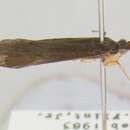Comprehensive Description
provided by Smithsonian Contributions to Zoology
Centromacronema nigripenne
This is a very small species that does not seem to have been described. It has a very distinctive appearance when alive or pinned, because it normally rolls its wings partially around the body appearing as a small twig rather than holding its wing flat over the body as do most species in this genus.
In coloration the wings are uniformly fuscous, with the head and thorax ventrally and legs pale yellowish-brown. The male genitalia offer clear differences from that of C. oculatum, the only other species presently known from the area, especially in the ninth segment dorsally, the length of the claspers, and apex of the aedeagus.
ADULT.—Length of forewing, 10–12 mm. Head and thorax dorsally and abdomen, fuscous; head and thorax ventrally and legs pale yellowish-brown; forewings fuscous. Male fifth abdominal sternum with a narrow, elongate dorsolateral raised lobe whose sides are narrowly enlarged. Male genitalia: Ninth segment with anterolateral margin rounded and slightly produced; dorsal margin only moderately elevated above tenth tergum, not produced posteriad. Tenth tergum elongate, apex not produced into a point. Clasper short, barely attaining apex of tenth tergum. Aedeagus with base at right angles to stem; apex enlarged, dorsoapical angle strongly produced into a pointed lobe; internally with a bandlike lateral structure and a small forked mesal rod.
MATERIAL.—Holotype, male: VENEZUELA, MIRANDA, Parque Nacional Guatopo, Santa Cruz de Rio Grande, 7 Feb 1976, C.M. and O.S. Flint, Jr. USNM Type 76616.
Paratypes: Same data as holotype, 1. ARAGUA: Rancho Grande, 17–20 Jan 1978, J.B. Heppner, 1; 25–26 Jan 1978, 1. 1 km S Rancho Grande, 5 Feb 1976, C.M. and O.S. Flint, Jr., 1. 3 km N Rancho Grande, 4 Feb 1976, C.M. and O.S. Flint, Jr., 1.
This is a large genus found in the Tropics of Africa, Madagascar, and the New World from the southwestern United States to central Argentina and the West Indies. Species may be very abundant in a preferred habitat, and because of their large size also one of the dominant insect species in terms of biomass. In addition to the five species encountered in the Río Limón basin, many more species are known in the country.
The larvae build a net and retreat attached to some solid object as is typical of the family. Different species often construct nets of different mesh size by which they partition the resources of the environment. Larvae of several species have been described (Flint, 1968; Marlier, 1964; Wiggins, 1977).
- bibliographic citation
- Flint, Oliver S., Jr. 1981. "Studies of Neotropical Caddisflies, XXVIII: The Trichoptera of the RA-o Limón Basin, Venezuela." Smithsonian Contributions to Zoology. 1-61. https://doi.org/10.5479/si.00810282.330

